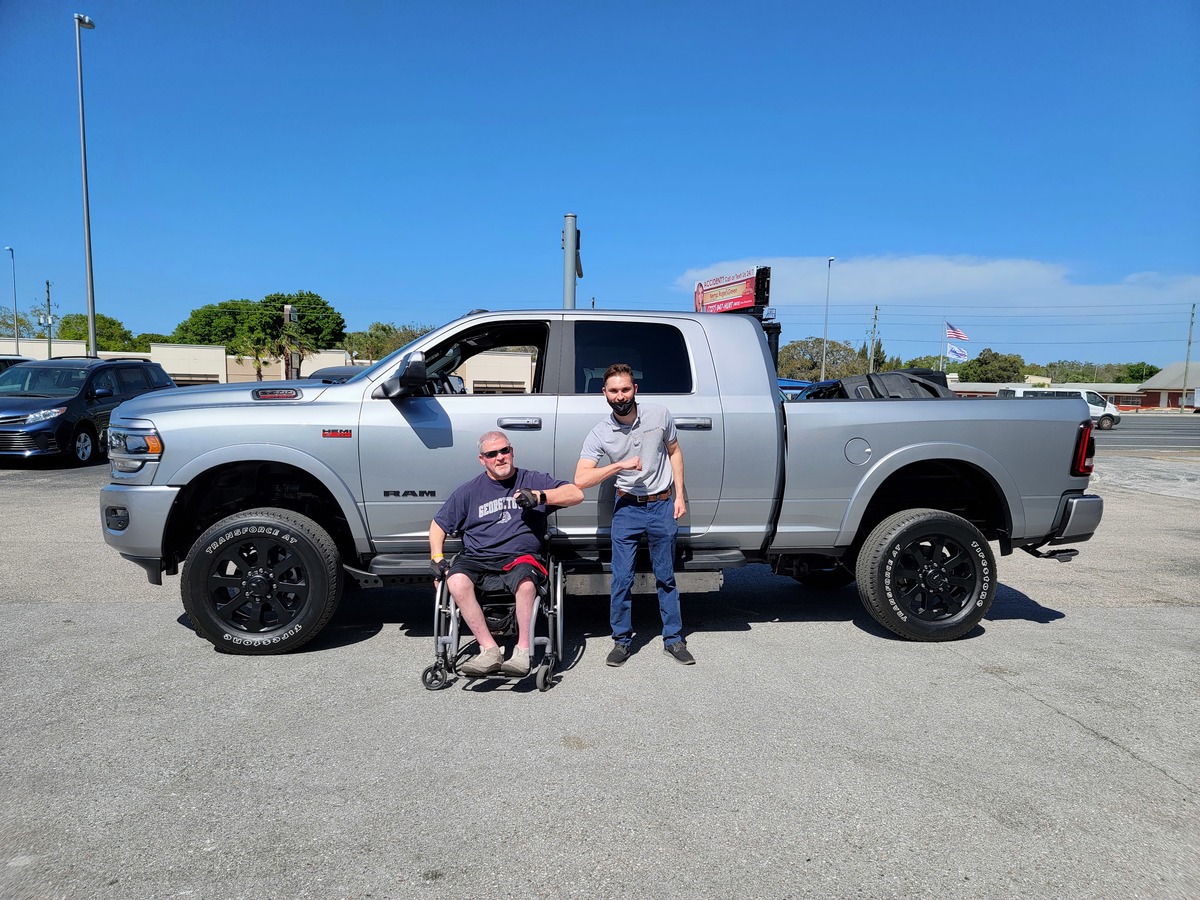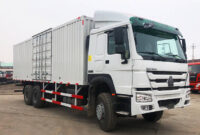Wheelchair Accessible Trucks For Sale: Your Comprehensive Guide to Freedom on Four Wheels pickup.truckstrend.com
For many, the image of a pickup truck evokes a sense of rugged independence, the capacity to haul, tow, and conquer various terrains, and a lifestyle centered around work or recreation. However, for individuals who rely on wheelchairs for mobility, the traditional truck, with its high ground clearance and elevated cabin, often remains an aspirational dream rather than a practical reality. This is where the world of wheelchair accessible trucks for sale steps in, transforming these versatile vehicles into empowering tools that offer unparalleled freedom and utility to wheelchair users.
A wheelchair accessible truck is a standard pickup that has undergone specialized modifications to allow a person using a wheelchair to enter, exit, and often drive the vehicle independently or with assistance. These conversions are meticulously engineered to ensure safety, comfort, and functionality, bridging the gap between desire and accessibility. For those seeking a vehicle that blends the robustness and utility of a truck with the vital necessity of wheelchair accessibility, understanding the options available is the first step towards a truly liberating purchase.
Wheelchair Accessible Trucks For Sale: Your Comprehensive Guide to Freedom on Four Wheels
Understanding Wheelchair Accessible Trucks
At its core, a wheelchair accessible truck is a testament to adaptive engineering. Unlike accessible vans, which often prioritize interior space and lower floors, accessible trucks typically focus on enabling entry into the cab of a standard pickup, maintaining its inherent capabilities. This means the primary modifications revolve around entry and exit systems, and sometimes, driving controls.
Key Modifications:
- Lifts: These are the most common and crucial modifications.
- Platform Lifts: These deploy from the side or rear of the truck, providing a flat platform that raises and lowers the wheelchair user. They can be mounted externally or, less commonly for trucks, internally.
- Under-Vehicle Lifts (UVL): Storing discreetly beneath the vehicle, UVLs are preferred for their unobtrusive nature, preserving the vehicle’s aesthetic and leaving the doorway clear. They are often more complex and expensive but offer a sleek solution.
- Modified Driving Controls: For individuals who wish to drive, a range of adaptive controls can be installed, including:
- Hand Controls: Allowing acceleration and braking via hand movements.
- Steering Aids: Spinner knobs, reduced effort steering, or zero-effort steering systems.
- High-Tech Driving Systems: Joysticks or other advanced electronic controls for severe mobility impairments.

- Securement Systems: Once inside, robust tie-downs or docking systems are essential to safely secure the wheelchair during transit, preventing movement and ensuring occupant safety.
- Transfer Seats: In some cases, power seats that rotate and extend outside the vehicle are installed to facilitate easier transfers from a wheelchair to the driver’s or passenger seat. While not making the truck "wheelchair accessible" in terms of direct entry, they improve the overall usability for some individuals.

Why Choose a Truck Over a Van?
While accessible vans are more common, trucks offer unique advantages:
- Towing Capacity: Trucks excel at towing boats, RVs, trailers, or other heavy equipment.
- Cargo Space: The open bed provides unparalleled versatility for hauling large, dirty, or oddly shaped items that wouldn’t fit inside a van.
- Ruggedness & Off-Road Capability: Many trucks are built for tougher terrains, appealing to those with outdoor or vocational pursuits.
- Personal Preference: For some, the aesthetic and driving experience of a truck are simply more appealing.
Types of Wheelchair Accessible Truck Conversions
The market for wheelchair accessible trucks is niche but growing, with specialized conversion companies leading the way. The type of conversion largely dictates the functionality and cost.
-
Lift-Equipped Pickups:
- Side-Entry Lifts: The most common configuration, where a lift deploys from the passenger or driver side, allowing the wheelchair user to enter the cab directly. This often requires significant structural modification to accommodate the lift mechanism and provide adequate entry clearance.
- Rear-Entry Lifts (less common for trucks): While popular for vans, rear-entry for a pickup truck’s cab is extremely rare due to the bed structure. However, lifts can be installed to access a modified bed with a canopy, suitable for transporting ATVs or other large mobility devices, not typically for passenger entry into the cab.
- Full-Size vs. Mid-Size Compatibility: Most conversions are performed on full-size trucks (e.g., Ford F-150, Chevrolet Silverado, Ram 1500) due to their robust chassis and available interior space, though some mid-size options may exist.
-
Specialized Chassis/Custom Builds:
- Some companies offer highly customized solutions, sometimes even building a bespoke body on a truck chassis to achieve a lower floor or unique entry system. These are exceptionally expensive and rare.
-
Transfer-Focused Conversions:
- For users who can transfer from their wheelchair to a vehicle seat, modifications like power transfer seats or custom steps can make a standard truck more accessible, even without a full lift system. These are not "wheelchair accessible trucks" in the sense of direct entry, but they enhance usability.
It’s crucial to understand that direct "lowered floor" conversions, common in accessible vans, are generally not feasible or practical for pickup trucks due to their frame-on-body construction and the need to maintain ground clearance for truck functionality. Therefore, lifts are the predominant method for direct wheelchair entry into a truck’s cab.
Benefits of Owning a Wheelchair Accessible Truck
The advantages of acquiring a wheelchair accessible truck extend far beyond mere transportation:
- Enhanced Independence: The ability to enter and operate a vehicle independently or with minimal assistance dramatically boosts self-reliance and quality of life.
- Unmatched Versatility for Lifestyle & Work: Whether it’s towing a boat to the lake, hauling supplies for a home project, carrying adaptive sports equipment, or navigating rural landscapes for work, a truck offers capabilities that no other accessible vehicle can match.
- Freedom to Explore: For outdoor enthusiasts, a truck opens up opportunities for camping, hunting, fishing, or off-road adventures that might otherwise be inaccessible.
- Robustness & Durability: Trucks are built tough, designed to withstand demanding conditions, which can translate to a longer lifespan and reliability, particularly in varied environments.
- Personal Preference & Image: For many, owning a truck is a lifestyle choice. An accessible truck allows individuals to align their vehicle with their personal identity and preferences.
Key Considerations Before Buying
Purchasing a wheelchair accessible truck is a significant investment and requires careful thought.
- Budget: Conversions are expensive. Factor in the cost of the base truck, the conversion kit, installation labor, and ongoing maintenance. New accessible trucks can easily range from $70,000 to $150,000+, while used options offer a more affordable entry point.
- Your Specific Needs:
- Wheelchair Type & Size: Ensure the lift and interior space can accommodate your specific wheelchair (manual, power, scooter).
- Driving vs. Passenger: If you plan to drive, assess the need for hand controls, steering aids, and transfer solutions.
- Caregiver Involvement: Consider if a caregiver will be assisting and their needs regarding space and operation.
- Usage: How will you primarily use the truck? Daily commute, recreational trips, work-related hauling?
- Vehicle Compatibility: Not all trucks are suitable for conversion. Consult with reputable conversion companies to identify compatible models and years.
- Lift Type: Evaluate the pros and cons of platform vs. under-vehicle lifts based on your preference for aesthetics, ease of use, and space requirements.
- Maintenance & Servicing: Accessible modifications require specialized maintenance. Research local service centers and understand warranty coverage for both the truck and the conversion.
- Safety & Certification: Ensure the conversion company adheres to safety standards (e.g., National Highway Traffic Safety Administration – NHTSA guidelines, ADA compliance for commercial use) and provides crash-tested securement systems.
- Resale Value: While niche, a well-maintained accessible truck can hold its value, but the market is smaller than for standard vehicles.
Where to Find Wheelchair Accessible Trucks For Sale
Finding the right accessible truck requires a targeted approach:
- Specialized Mobility Dealerships: These are your best resource. They specialize in accessible vehicles, have knowledgeable staff, often offer financing, and can guide you through the conversion process or show you pre-converted models.
- Authorized Conversion Companies: Many companies that perform conversions also sell direct. They can custom-build a truck to your specifications.
- Online Marketplaces: Websites dedicated to accessible vehicles (e.g., NMEDA.com, MobilityWorks.com, VanProducts.com, Agoravans.com) are excellent places to start. General used car sites (Autotrader, Cars.com) may also list them, but you’ll need to use specific search filters.
- Private Sellers: While potentially cheaper, buying privately carries more risk. Ensure you get a thorough inspection by an independent mechanic specializing in accessible vehicles.
- Government & Non-Profit Programs: Some state vocational rehabilitation programs or non-profit organizations offer grants or financial assistance for vehicle modifications.
The Buying Process: A Step-by-Step Guide
- Assess Your Needs Thoroughly: Before looking at trucks, precisely define your mobility requirements, desired features, budget, and intended use.
- Research & Identify Options: Explore different truck models, conversion types, and reputable conversion companies. Read reviews and gather information.
- Connect with Reputable Dealers/Converters: Reach out to several to compare options, get quotes, and understand their process and warranties. Look for NMEDA (National Mobility Equipment Dealers Association) certified dealers.
- Test Drive (Crucial!): If possible, test drive a similar accessible truck. Pay attention to how the lift operates, ease of entry/exit, interior space, and driving comfort (if you plan to drive).
- Inspect the Conversion: Have an independent, qualified mechanic (ideally one familiar with mobility conversions) perform a pre-purchase inspection on both the truck and the conversion equipment. Check the condition of the lift, tie-downs, and adaptive controls.
- Understand Warranties & Service: Clarify what is covered under warranty for both the base vehicle and the conversion. Ask about recommended maintenance schedules and where service can be performed.
- Explore Financing & Funding: Discuss financing options with the dealer or your bank. Research grants, state assistance programs, or manufacturer rebates for adaptive equipment.
- Negotiate & Purchase: Once satisfied, negotiate the price and complete the purchase. Ensure all documentation, including warranties and service records, is provided.
Challenges and Solutions
While wheelchair accessible trucks offer immense benefits, they come with unique challenges:
- High Cost:
- Solution: Explore financing options, manufacturer rebates, state vocational rehabilitation grants, or non-profit assistance programs. Consider purchasing a pre-owned accessible truck.
- Limited Availability:
- Solution: Be prepared to travel to specialized dealerships or wait for a custom conversion. Broaden your search to national listings.
- Maintenance Complexity:
- Solution: Budget for specialized maintenance. Find certified technicians experienced with mobility equipment. Regular preventive maintenance is key.
- Parking & Maneuvering:
- Solution: Lifts require clear space to deploy. Practice parking in various scenarios. While lifts add complexity, the overall footprint is similar to a standard truck.
- Weather Impact on Lifts:
- Solution: Lifts can be affected by extreme cold, ice, or snow. Consider a truck with an enclosed parking spot or a protective cover for the lift if frequently exposed.
Price Table: Wheelchair Accessible Trucks For Sale (Estimated Ranges)
Prices for wheelchair accessible trucks vary significantly based on the base vehicle (new vs. used, make/model/trim), the type and complexity of the conversion, specific adaptive equipment added, and labor costs. The table below provides estimated ranges for general guidance.
| Component / Type | Description | Estimated Price Range (USD) | Key Factors Affecting Price |
|---|---|---|---|
| Base Truck (New) | New Pickup Truck (e.g., Ford F-150, Chevy Silverado, Ram 1500, Toyota Tundra) | $35,000 – $80,000+ | Make, Model, Trim, Features, Engine, Drivetrain |
| Base Truck (Used) | Used Pickup Truck (5-10 years old, good condition) | $15,000 – $40,000+ | Age, Mileage, Condition, Model, Features, Region |
| Wheelchair Lift (Platform) | Exterior or Interior-mounted platform to raise/lower wheelchair | $10,000 – $25,000 | Brand, Weight Capacity, Features (automatic, fold-away), Installation Complexity, Material Quality |
| Wheelchair Lift (Under-Vehicle) | Stows discreetly beneath the vehicle, preserving interior space | $18,000 – $35,000 | Brand, Weight Capacity, Installation Complexity, Vehicle Compatibility, Motor Type |
| Hand Controls | Mechanical or Electronic devices for accelerating and braking by hand | $1,000 – $4,000 | Type (push/pull, push/rock), Electronic vs. Mechanical, Customization, Installation |
| Steering Aids | Spinner knobs, reduced effort steering, zero effort steering | $100 – $5,000 | Complexity, Integration with existing system, Brand, Features |
| Transfer Seats | Power seats that rotate and/or move out of the vehicle for easier transfers | $3,000 – $10,000 | Brand, Movement capability (swivel, lift, recline), Customization, Installation |
| Wheelchair Securement Systems | Tie-downs (manual or automatic), docking systems for securing wheelchair | $500 – $3,000 | Type (retractable, manual), Brand, Crash-tested certification, Installation |
| Complete Accessible Truck (Used, Pre-Converted) | A used truck already modified for wheelchair accessibility. | $30,000 – $80,000+ | Age of vehicle, Age of conversion, Mileage, Condition, Conversion type & features, Seller (dealer vs. private) |
| Complete Accessible Truck (New, Custom Ordered) | A new truck purchased and then custom-converted with chosen features | $70,000 – $150,000+ | Base truck cost + chosen conversion components + labor + advanced customization, Specificity of modifications |
| Additional Modifications | Power doors, remote entry, advanced electronic controls, custom interior | $500 – $5,000+ (each) | Specific feature, Brand, Installation complexity, Level of integration with vehicle’s existing systems |
| Installation Labor | Cost of professional installation for all components (often included in conversion kits) | Varies (often 20-40% of component cost) | Shop rates, Complexity of installation, Number of modifications |
Frequently Asked Questions (FAQ)
Q1: How much does a wheelchair accessible truck typically cost?
A1: The cost varies widely. A used, pre-converted accessible truck can range from $30,000 to $80,000+, while a new truck with a custom conversion can easily exceed $70,000, often reaching $150,000 or more depending on the truck model and complexity of modifications. Refer to the price table above for more details.
Q2: Can any pickup truck be converted for wheelchair accessibility?
A2: Not every truck is suitable. Conversion companies typically work with specific full-size truck models (like Ford F-Series, Chevy Silverado, Ram, Toyota Tundra) that have the structural integrity, space, and aftermarket support for safe and effective modifications. Always consult with a certified mobility dealer or converter.
Q3: Are wheelchair accessible trucks safe?
A3: Yes, when converted by reputable, certified companies that adhere to federal safety standards (like those set by NHTSA) and use crash-tested equipment. It’s crucial to ensure the conversion company is NMEDA certified and that all securement systems meet industry safety standards.
Q4: What’s the main difference between an accessible truck and an accessible van?
A4: Accessible vans often feature lowered floors, providing more interior space and easier entry via ramps. Trucks, on the other hand, typically use lifts to overcome their higher ground clearance, maintaining their inherent towing, hauling, and off-road capabilities. The choice depends on individual lifestyle, cargo needs, and preference for vehicle type.
Q5: Are there financial assistance programs for buying an accessible truck?
A5: Yes. Many states offer vocational rehabilitation programs, and non-profit organizations provide grants for vehicle modifications. Additionally, some vehicle manufacturers offer rebates for adaptive equipment. Veterans may also qualify for assistance through the VA. It’s recommended to research local and national programs.
Q6: How long does a truck conversion take?
A6: The timeline varies based on the complexity of the conversion and the converter’s schedule. Simple modifications might take a few weeks, while a comprehensive, custom-built accessible truck could take several months from order to delivery.
Q7: What about the warranty on an accessible truck?
A7: Typically, there are two separate warranties: one for the base vehicle from the manufacturer, and another for the conversion equipment and labor from the conversion company. It’s important to understand the terms and coverage of both.
Conclusion
The realm of wheelchair accessible trucks for sale represents a significant leap forward in mobility, offering a unique blend of rugged utility and vital accessibility. For individuals who crave the power, versatility, and distinctive appeal of a pickup truck, these specially modified vehicles transform a dream into a tangible reality.
While the journey to acquire an accessible truck involves careful research, financial planning, and a thorough understanding of available options, the ultimate reward is profound. It’s not merely about buying a vehicle; it’s about investing in independence, expanding horizons, and embracing a lifestyle unconstrained by traditional mobility limitations. With the right information and guidance, the open road, the challenging job site, or the serene wilderness can truly become accessible to all.




